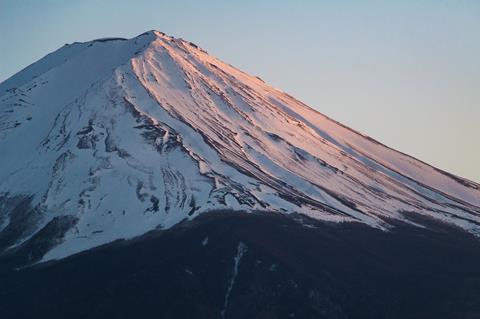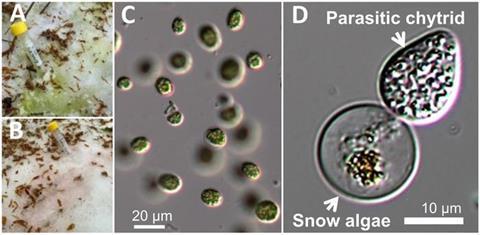The microbial communities found in glacier and snowpack ecosystems are an essential part of cold weather environments.
Chytrids, a group of fungi that include well-known frog pathogens, are often found in abundance in these ecosystems, but culturing these organisms and learning more about their lifecycle, including their relationship to the snow algae found in these environments, has proven challenging.

In a recently published paper, researchers revealed that they were able to analyze chytrid DNA from two alpine snowpack sites in Japan using single-spore PCR. The paper was published in Frontiers in Microbiology on June 20.
World first
“We have captured the chytrids on snow algae and succeeded in extracting DNA from a single spore for the first time in the world,” said Hiroaki Nakanishi, a master student at Yokohama National University in Yokohama (YNU), Japan, and a corresponding author of the research. “The chytrids detected in cold environments were revealed to be a parasitic species of algae that grow on snowpacks and glaciers, known as snow algae.”
In the seasonal snowpacks in alpine Japan, snow algae grow during snowmelt, turning the surface of the snow red and green. These algae also speed up the snowmelt process by increasing the absorption of solar radiation. Studies of the snowmelt from these regions of Japan revealed chytrid fungi - however the relationship between the snow algae and the chytrids was unclear.
“Recent DNA analysis has revealed that some species of chytrids are able to grow in cold environments. They have been reported to be present under alpine snowpacks or in soil around glaciers, even on top of the snowpacks or glaciers. However, it was unknown if they were parasitic species of some organisms or simply decomposers of organic matter,” said Nakanishi.
Single-spore PCR
In order to understand the phylogenetic position of the chytrids, researchers used single-spore PCR to sequence chytrids that were found in a bloom of snow alga. Chytrid cells were isolated from samples taken from both green and red snow from two different sites in Japan.

Molecular phylogenetic analysis showed three novel lineages of chytrids that are related to chytrid lineages found worldwide, called Snow Clade.
The first lineage was related to chytrids found in other snowy climates worldwide, including the lakes of Switzerland, river water in Alberta, Canada, and snow in the Rocky Mountains in Colorado, United States. The second lineage is related to chytrids found in glaciers on Mt. Kilimanjaro in Tanzania. And the third lineage was found to be completely unique and independent from the others.
Infecting snow algae
Through DNA analysis and observation, researchers can confirm that chytrids do infect snow algae in the same way they infect other algae populations worldwide. Prevalence of the chytrids in the algae samples was 5.3%, but researchers caution that a low prevalence does not necessarily mean a low impact. In lakes, chytrids suppress algal population, but the infection prevalence is not always high.
More research is needed to fully understand these alpine chytrids and the impact they have on their snowy ecosystems.
“It has been shown that the growth of snow algae colors the surface of snow and glaciers and accelerates snowmelt.” said Maiko Kagami, a professor of YNU, and another corresponding author of the research.
Glacier ecosystems
“However, the chytrids may inhibit the melting of glaciers and snowpack by parasitizing and killing snow algae. Chytrids are often considered dangerous because of the well-known frog pathogen, Batrachochytrium dendrobatidis. Further research will help us understand the newly discovered microbial interactions and give some hints to protect glacier ecosystems that are predicted to disappear during the 21st century,” Kagami added.
Other contributors include Dr. Kensuke Seto of Yokohama National University and Prof. Nozomu Takeuchi of Chiba University. The JSPS KAKENHI Grant-In-Aid for Scientific Research supported this research.







No comments yet